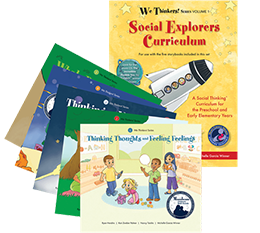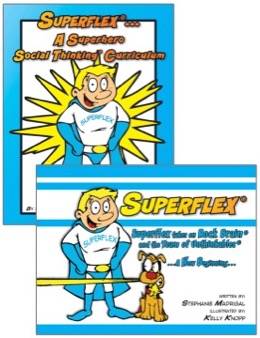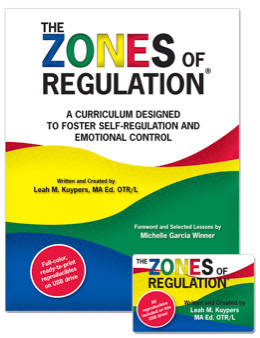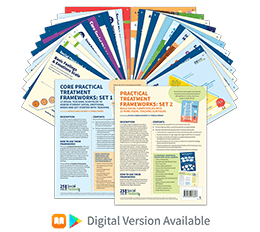Social emotional learning is a lifelong process
We are all social emotional learners. Over the course of our lives, we cycle through different phases of gathering knowledge about how the social world works and then use that information to work (navigate to regulate) in the social world. Being a social emotional learner is a lifelong process.
The Social Thinking Methodology has age-based and strength-based products and materials for social emotional learners. We define social emotional learners as both neurotypical and Neurodivergent (e.g., ADHD, social communication, social anxiety, twice-exceptional, sensory processing, specific learning disabilities, autism levels 1 and 2). Social emotional learners who benefit from our methodology are those who “learn with language” and “think and talk about thinking.” Actually, we are all social emotional learners.

Helping social emotional learners understand the social world
The social world is an enormous place for social emotional learners. It is also a complicated, messy arena where social rules change with age, people, and places. It is dynamic and unpredictable and yet most of us learn to manage ourselves around others despite the complexity. Being a social emotional learner is something we are expected to do over the course of our lives. We all experience periods of development where we gather and learn new information about how the social world works at our current stage of development: infant, child, teen, young adult, or elder. Sometimes learning how the social world works is neither intuitive nor logical, but it is based on development. The Social Thinking Methodology breaks down this complex learning into digestible parts based on the social emotional learner's age and abilities.
Early learners (ages 4-7)
Very young social emotional learners observe others and gradually learn how to interpret what they see and experience. Young children develop their observational skills during play and from being around others. Introducing unique Social Thinking Vocabulary to early learners helps in their understanding of thoughts and feelings, reading others' plans, and understanding groups and themselves as participants in the social world. Young children also need to learn about their many different feelings by learning about their Zones of Regulation.
Elementary (ages 8-11)
Materials and tools for this age range are more sophisticated but still rely on visual supports and concrete examples. Social emotional learners gradually hone their social detective abilities as they learn to observe the explicit and hidden social expectations of situations. Social emotional learners also learn about themselves and the way the social world works in social situations by playing motivational games (Should I? or Shouldn't I?) that teach about perspective taking and unspoken social expectations. This information seeds their emerging ability to navigate to regulate in the social world. At school the social world is also explored in literature, history, and social studies. Social emotional learners connect what they learn about the social world into their academic assignments in reading comprehension and written expression.
Adolescent and young adult (ages 12+)
Adolescence and young adulthood are tumultuous social developmental phases. As tweens and teens, learning how the social world works sometimes means shedding the ideas of childhood by understanding the complexities of friendship (Friendship Pyramid) and the four key components of communicating with others (4 Steps of Communication) while also learning how perspective taking becomes more sophisticated. Organizational skills become more dynamic, requiring individuals to prepare for increasingly complex assignments.
Social Thinking Vocabulary continues to play a role as older social emotional learners come to appreciate that what others do or say affects their own thoughts and feelings. We make connections between actions, reactions, and emotions in our book, Social Situation Mapping. Learning how the social world works is a lifelong process because our expectations for how social emotional learners work (navigate to regulate) in the social world changes too. Older adults are still learning and can find core information in our award-winning book for adults, Social Thinking at Work.
Practical tools to match the social learner
Learning how the social world works is only part of the social equation. Once learners have the fundamentals of the social world, they need to understand how to work (navigate to regulate) in the social world. It's one thing to intellectually know what to do in a situation and another thing to do it during real-time social situations! The Social Thinking Methodology uses motivating and practical strategies to teach individuals to use all the social knowledge they have learned about the social world to help them navigate through social situations and self-regulate to meet their personal social goals.
Early learners (ages 4-7)
Knowledge about how the social world works now becomes the launching pad that younger learners use to practice flexible thinking, problem solving, , and putting it all together to become “We-Thinkers” rather than “Me-Thinkers.” Learners this age can also begin to see how others’ behaviors can impact their thoughts and emotions (and vice versa).
Elementary (ages 8-11)
Social emotional learners in this age range are learning to use strategies for smart guesses, flexible thinking, size of the problem, and other core Social Thinking Vocabulary found in our award-winning book, Social Thinking and Me. Having gained social observation tools learned from being a social detective, they are ready to learn about Superflex…A Superhero Social Thinking Curriculum. Learners go to the Superflex Academy where they learn to transform themselves into social thinking superheroes! They also learn strategies for managing UnthinkaBots (formally called Unthinkables) and activating their strategies (Thinkables). The Superflex Curriculum uses illustrated storybooks and fun, motivating lessons to teach practical strategies for supporting focus (Superflex takes on Brain Eater and the Team of Unthinkables and Superflex and Focus Tron to the Rescue), dealing with problems and solutions (Superflex takes on Glassman… and Superflex and Kool Q Cumber to the Rescue), and one-sided thinking (Superflex takes on One-Sided Sid and Un-Wonderer).
Social Town is a book where Neurodivergent students submitted their ideas about their own Unthinkables/UnthinkaBots. This book introduces kids to 82 additional characters and shares a Very Cool Five-Step Power Plan. Other fun materials in the Superflex Universe include Superflex games such as Superflex Bingo and the Thinkables and UnthinkaBot Double Deck.
Finally, elementary social emotional learners are also ready to take a deeper dive into thinking and learning about the impact of their thoughts on themselves and others (The Power of Thought on Feelings) and how to navigate to regulate their feelings and behaviors using the award-winning The Zones of Regulation.
Adolescents (ages 12+)
Social emotional learners in the teen years tend to have more obstacles as they use the social world knowledge they have gained. For example, anxiety, angst, risk aversion, and normal developmental awkwardness can hinder how social emotional learners navigate classrooms, cliques, and community. The Social Thinking Methodology uses Thinksheets (rather than worksheets) to encourage deeper learning and build competencies. Visual tools, such as the Spirals of Anxiety, are designed to give practical strategies for coping with anxiety. Social Thinking Vocabulary, such as learning to be comfortable with discomfort, are key in this age range. Social Situation Mapping is a powerful tool to teach the Social Emotional Chain Reaction (how our thoughts, feelings, behaviors, and reactions are all intertwined). Teen-friendly Manga-style comics in our book, Social Fortune or Social Fate, teach this concept and motivate teens to keep their social emotional learning alive.
Young adult (18+) and adulthood
Young adults (and parents of children of all ages) will find a broad comprehensive overview of the key components of the Social Thinking Methodology in multiple award-winning book Socially Curious and Curiously Social. This practical guide speaks to the teen or young adult through age-relevant stories and examples, in language that’s easy to read and understand. Practical strategies for both understanding how the social world works and working in the social world for mature adults can be found in the award-winning book Social Thinking at Work.

We Thinkers! Volume 1 Social Explorers Deluxe Package
Our premier social emotional learning package for children ages 4–7 helps develop foundational social competencies. The multiple award-winning We Thinkers! Volume 1: Social Explorers includes five storybooks and a thorough unit-by-unit curriculum. The storybooks correspond to and support detailed lessons for teaching five evidence-based concepts that establish a common social vocabulary for early learners and are fundamental to all social experiences. These practice-proven materials are designed for both neurotypically developing children and those with social learning differences and/or challenges to strengthen perspective taking, self-awareness, and so much more. The We Thinkers! series is loved around the world by kids, parents, and professionals alike!

Superflex Curriculum
Kids around the world are having fun learning about their own super-strengths using the Superflex® Curriculum. Students learn how to become a flexible superhero through engaging and motivating activities. Often without realizing it, they develop flexible-thinking, perspective-taking, and self-regulation strategies. This two-book set comes with a storybook about how one Superflex (Aiden) takes on a group of imaginary creatures called UnthinkaBots (previously called Unthinkables), specifically Rock Brain. Kids learn that they too can become their own superhero and manage their own team of UnthinkaBots. The curriculum guide includes lessons, handouts, and visual tools to transform your classroom, clinic, or home into a Superflex Academy.

Social Thinking and Me
Our best-selling and award-winning curriculum is a powerhouse of social knowledge that introduces Social Thinking Vocabulary and concepts through colorful illustrations and easy-to-understand content. These well-organized books help children become stronger social observers and social problem solvers and give adults the teaching tools they need to break down and teach complex social concepts.

The Zones of Regulation
The Zones of Regulation is an easy-to-use framework and award-winning curriculum for teaching strategies for emotional and sensory self-management. The Zones curriculum uses four colors to help students identify how they are feeling in the moment given their emotions and level of alertness and guides them to strategies to support their own self-regulation. By understanding how to read their bodies and detect triggers, students learn improved emotional awareness, sensory regulation, and problem solving.

Social Thinking Frameworks Collection
Got complicated kids? We’ve got 26 powerful visual tools to help you and your social learners crack open the social emotional world—all in one collection. We’ve distilled 25 years of our core learning and teaching into hands-on, ready-to-use , 8.5” x 11” scaffolds to help both interventionists and social learners organize, talk about, understand, and navigate diverse social landscapes.








